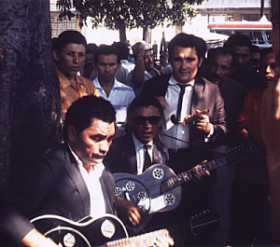CORDEL’S
ROLE FOR ITS BRAZILIAN PUBLIC
 The
booklet of cordelian poetry first of all entertains in its role as the primary
written document of the folk-popular literary tradition in much of Brazil, a
tradition coming from the chapbook literature of Portugal, Spain, France and
Italy. In these stories the Brazilian reader discovers medieval
chivalry in the stories of Charlemagne and the Twelve Knights, old fairy tales
including Snow White, the oriental tales of Aladdin and Ali Baba, and
traditional Catholic stories of Jesus, Mary and the saints and their battles
against the evils of Satan. In
addition, there is a plethora of love and adventure stories, of princes and
princesses, of monsters and dragons to be slain.
And there is humor, the Brazilian quengo or amarelo, the
local version of the clever rogue, a pícaro who survives by wit. In almost all these story-poems there is present a strong,
moral undercurrent: Good conquers Evil in all its forms.
The
booklet of cordelian poetry first of all entertains in its role as the primary
written document of the folk-popular literary tradition in much of Brazil, a
tradition coming from the chapbook literature of Portugal, Spain, France and
Italy. In these stories the Brazilian reader discovers medieval
chivalry in the stories of Charlemagne and the Twelve Knights, old fairy tales
including Snow White, the oriental tales of Aladdin and Ali Baba, and
traditional Catholic stories of Jesus, Mary and the saints and their battles
against the evils of Satan. In
addition, there is a plethora of love and adventure stories, of princes and
princesses, of monsters and dragons to be slain.
And there is humor, the Brazilian quengo or amarelo, the
local version of the clever rogue, a pícaro who survives by wit. In almost all these story-poems there is present a strong,
moral undercurrent: Good conquers Evil in all its forms.
Cordel entertains as well with the written version of the oral,
improvised poetic duel known in Portuguese as peleja, desafio, cantoria
or repente. Two poets face each other, and wit, intelligence and a quick
tongue determine the winner.
The current event story-poems chronicle religious, social, economic and
political events and their protagonists during the entire twentieth century.
Religious fanatics and wars in the backlands, Robin Hood-like bandits who
ravaged the Northeast for almost forty years, and the ups and downs of national
political and economic life – these are all the staples of cordel.
The poetry chronicles the infant First Republic, the upheaval of the
1920s, and the odyssey of revolt, revolution, Corporate State and finally,
workers democracy, under Brazil’s most famous politician, Getúlio Vargas.
What comes next is the dynamic and chaotic quest for democracy for the
next ten years under President Kubitschek and the founding and building of
Brasília,
Jânio Quadros’ eccentricities in his efforts to sweep away the corruption of
the past during six brief months in office, and reformer-leftist Jango
Goulart’s turbulent four years. Cordel
then tells of the balance of the century in the dark years of the military
dictatorships from 1964 to 1985 and the return to “normalcy” and Brazil’s
quest ever since for a place in the sun (other than the beaches of Ipanema or
Itapuã).
Cordelian
reporters looked outside Brazil as well and chronicled World War I, World War
II, and the major international conflicts since then, giving emphasis to the
role of the United States of America and its leaders.
Finally, cordel directly or indirectly always teaches.
It offers traditional Catholic “old church” teachings in stories on
traditional religion and morality. But
Brazilian religious syncretism and
flexibility of character allow as well Kardec Spiritism, Afro-Brazilian religion
and Indian spiritism. In moral
“examples” cordel tells the reader how to live, but most often with
tongue in cheek in stories like The Girl Who Beat Up Her Mother on Good
Friday and Was Turned into a Dog.
One can say, in summation, that cordel in its totality portrays life in
the twentieth century.